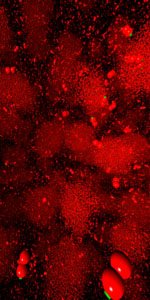Particle-based Data are no Point-Clouds

Not all points are equal. There are always fundamental misconceptions about the type of data I am working with in my visualization research.
I work with particle data. This data is usually the result of simulations, e.g. generated through the methods of molecular dynamics or a discrete element method. The individual particles represent independent elements, e.g. atoms or mass centers, which are neither connected nor correlated. Of course, within the simulation these particles interact and influence each other, but with the pure data which is available for visualization to me, there is no topological structure between the particles at all. Literature was several further names for this kind of data: point-based data, mesh-less data, and, maybe the best fitting one, scattered data. Technically speaking, these data sets are arbitrarily sorted lists of elements, each storing a position and optional additional attributes, like a sphere radius or a color. But that is it. There are no more information and in general you cannot make any assumptions about structures within the data.
 I now want to write about one very common misconception: there is the further data type of point clouds also called point-set surfaces. These data also consist of a list of points, which are at first not correlated. Typical sources of such data are point-based modeling in 3D computer graphics and, more common, scanning of real-world objects. Such scans would be created by laser scanners or structured-light scanners like the Kinect. Because of the fact that these data sets store a simple list of points, i.e. they are technically identical to particle data, results in the misconception of many people that these two types of data sets are identical. They are not.
I now want to write about one very common misconception: there is the further data type of point clouds also called point-set surfaces. These data also consist of a list of points, which are at first not correlated. Typical sources of such data are point-based modeling in 3D computer graphics and, more common, scanning of real-world objects. Such scans would be created by laser scanners or structured-light scanners like the Kinect. Because of the fact that these data sets store a simple list of points, i.e. they are technically identical to particle data, results in the misconception of many people that these two types of data sets are identical. They are not.
Point clouds are discrete samplings of a continuous function, i.e. the surface of the scanned or modeled object. Therefore, all points reside, within some error margin, on this 2D surface embedded within the 3D space. This aspect is fundamentally different from particle data, in which the particles are freely placed throughout the 3D space. Almost every algorithm working with point-cloud data work with the assumption of the continuous surface represented by the points. As this assumption is not valid for particle data, these algorithms cannot be applied easily to this kind of data.
Well, obviously I have not published enough to make my colleagues in my field of science recognizes this difference. I am off then …

Leave a Reply